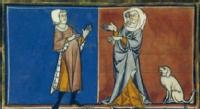La Châtelaine de Vergy
The Châtelaine de Vergy is one of the most accomplished works of narrative literature to emerge from the Middle Ages. Written towards the middle of the thirteenth century, this 'nouvelle' of 948 verses gave rise to numerous imitations and rewritings in European literature that extended well into the sixteenth century. Though the medieval story presents itself as an exemplary tale, the work raises more questions than it answers. Here are some ideas for seminar preparation which should help you to get a better grip on this enigmatic medieval text and the issues it raises:
Seminar 1
Examine the importance of the various relationships in the story (between lovers, married partners or lord and vassal). How do these relationships structure the narrative and what is their significance?
How are men and women represented in the story? In answering this question, you might like to think about gender relations as well as characterisation.
Why does the Châtelaine die? Who, in your view, is to blame for her death? Support your answer with reference to the text.
Are each of the characters justified in acting the way they do (you may like to think especially here of the duke, his wife and the knight)? In what ways are their actions justified (or not)? To what extent does each character have a choice in how they act?
Following on from the question of action and how it can/can’t be justified, how would you describe the ethical dilemma presented by this text? To what extent is this a dilemma that can be resolved?
What is the meaning of this story? Does it have a moral message to convey? To what degree does this message fit with your own reading of the text?
Seminar 2
Examine the use of direct discourse in the story. How is it used? What are the effects of using this narrative technique?
What kind of love is represented in this text? What are its characteristics? You might like to do some independent research on courtly love (usually known as ‘fin’amors’ in the Middle Ages); however, try to base your answers on close analysis of the text itself as well.
Does the knight betray his lady? If he does, how does he betray her and at what point does he do so?
Would you agree with Simon Gaunt that the Châtelaine is the only true martyr to love in this text?
Having considered the challenges presented by this text, what do you think the best way of approaching it critically might be? How far do things like historical context, textual framing (i.e. prologues/epilogues), or close reading help you in interpreting this text? You might like to compare how other critics have interpreted the story (e.g. Ramm, Hunt, Gaunt, Zumthor) and consider the advantages or disadvantages of the approaches they choose to adopt.

